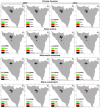Future habitat dynamics of critically endangered endemic plants in the St. Catherine protected area, South Sinai, Egypt: climate change perspectives on mountain ecosystems
- PMID: 40640714
- PMCID: PMC12243221
- DOI: 10.1186/s12862-025-02408-5
Future habitat dynamics of critically endangered endemic plants in the St. Catherine protected area, South Sinai, Egypt: climate change perspectives on mountain ecosystems
Abstract
Background: Mountain ecosystems provide crucial insights into species distribution, yet their fragility, especially in the warming Mediterranean, puts many species at high extinction risk. This study, focusing on four critically endangered plants in Egypt's St. Catherine Protected Area (Primula boveana, Rosa arabica, Micromeria serbaliana, and Silene oreosinaica), uses Species Distribution Models (MaxEnt) and the IUCN Red List to assess climate change impacts and enhance future conservation strategies.
Results: Field observations from 2024 to 2025 revealed changes in Extent of Occurrence (EOO) and Area of Occupancy (AOO) when compared to historical records. EOO increased for all species: P. boveana (72.8 km², + 280%), R. arabica (102 km², + 117%), M. serbaliana (88.5 km², + 30%), and S. oreosinaica (61 km², + 15%) as discovery of new and rehabilitated sites. This reclassified R. arabica from Critically Endangered (CR) to Endangered (EN), although the other species remain CR. Despite these geographical increases, both human and natural threats continue to cause declines in individual numbers and habitat quality. High predictive model accuracy was recorded (AUC ≥ 0.97, TSS ≥ 0.85). Under current conditions, P. boveana and R. arabica exhibit wider potential distributions (11.3% and 12.1% of the total area, respectively) than M. serbaliana (5.2%) and S. oreosinaica (5.4%). Areas with high probability of occurrence are primarily found in the northwestern mountains, often fragmented by topography. MaxEnt projected a decline in suitable habitats for these species, with new suitable areas emerging in SCPA's southern mountains. Future habitat reduction rates for the years 2050 and 2070 varied: S. oreosinaica (2-23%), P. boveana (7-32%), and M. serbaliana (2-41%), while R. arabica demonstrated high stability (> 96%).
Conclusions: Our findings show an altitudinal shift, with species moving to higher, southern mountains, experiencing habitat fragmentation and losses elsewhere. Effective conservation needs ongoing monitoring, in-situ/ex-situ efforts, and addressing threats like overgrazing. Raising environmental awareness is crucial.
Keywords: Conservation monitoring; Habitat suitability; IUCN red list; Maxent; Prioritization; Restricted range species; Spatial changes; Species distribution modeling.
© 2025. The Author(s).
Conflict of interest statement
Declarations. Ethic approval and consent to participate: All methods used in this study followed the relevant institutional, national, and international guidelines and legislation, and no animal or plant parts were collected. Consent for publication: All authors participated in, read and approved the final version of the article before publication. Prior to publication, written informed consent was secured from all authors whose personal identifying images appear in this study. They were fully informed of how their images would be used and disseminated in this publication. Competing interests: The authors declare no competing interests.
Figures








References
-
- Lewis SL, Maslin MA. Defining the anthropocene. Nature. 2015;519(7542):171–80. 10.1038/nature14258. - PubMed
-
- Barnosky AD, Matzke N, Tomiya S, Wogan GOU, Swartz B, Quental TB, et al. Has the earth’s sixth mass extinction already arrived? Nature. 2011;471(7336):51–7. 10.1038/nature09678. - PubMed
-
- Heller NE, Zavaleta ES. Biodiversity management in the face of climate change: A review of 22 years of recommendations. Biol Conserv. 2008;142(1):14–32. 10.1016/j.biocon.2008.10.006.
-
- Pereira HM, Leadley PW, Proença V, Alkemade R, Scharlemann JPW, Fernandez-Manjarrés JF, et al. Scenarios for global biodiversity in the 21st century. Science. 2010;330(6010):1496–501. 10.1126/science.1196624. - PubMed
-
- Thomas CD, Cameron A, Green RE, Bakkenes M, Beaumont LJ, Collingham YC, et al. Extinction risk from climate change. Nature. 2004;427(6970):145–8. 10.1038/nature02121. - PubMed
MeSH terms
Grants and funding
LinkOut - more resources
Full Text Sources
Medical
Research Materials
